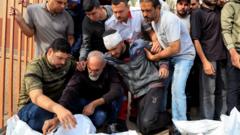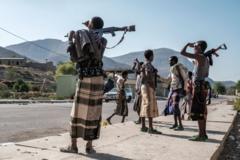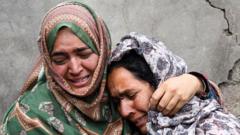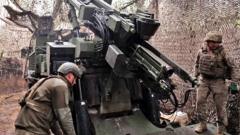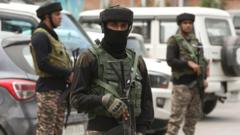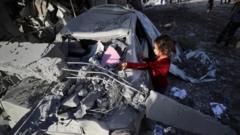As India and Pakistan exchanged missile strikes and artillery fire in Kashmir, civilians like 16-year-old Nimra and 13-year-old Vihaan became tragic victims. The strikes, instigated by a militant attack in India-administered Kashmir, culminated in a tense ceasefire brokered by international players after significant casualties on both sides.
Escalation in Kashmir: A Four-Day Conflict Between India and Pakistan
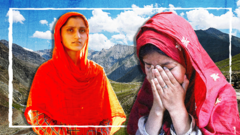
Escalation in Kashmir: A Four-Day Conflict Between India and Pakistan
The recent four-day exchange of missiles and shelling between India and Pakistan in Kashmir has resulted in civilian casualties and a precarious ceasefire that reflects the fragility of peace in the region.
The escalation began following a militant attack in India-administered Kashmir that claimed 26 lives, primarily Indian tourists. Subsequently, India launched retaliatory strikes targeting Pakistan-administered Kashmir, claiming military bases as targets. As the shelling intensified over four days, casualties mounted: at least 16 reported dead in India, and Pakistan claiming 40 civilian fatalities.
In the emotional narratives shared by families on both sides, we hear terrifying accounts of horror and loss. Nimra found herself injured by shrapnel while fleeing, whereas Vihaan’s family experienced the heartbreaking loss of their 13-year-old son due to shelling. On the Pakistani side, residents like Muhammed Shafi witnessed the instant devastation of loved ones, with his wife being killed in a strike just moments from him. Daily life interrupted, many families sheltered in fear, but tragically, even safe havens turned unsafe.
Efforts by both governments to respond to the situation involved drone and missile exchanges that only worsened tensions. On a diplomatic level, the context was complicated by increased military preparation and credibly stark warnings from both nations. Just as the possibility of broader conflict loomed, a ceasefire was brokered on May 10, 2023, by US and other international players, yet questions linger about the effectiveness of the arrangement and future stability in the region.
The shared desire for peace among civilians clashed against the backdrop of military strategies and political maneuvering, underscoring once again the complex reality of life along one of the world's most contested borders.
In the emotional narratives shared by families on both sides, we hear terrifying accounts of horror and loss. Nimra found herself injured by shrapnel while fleeing, whereas Vihaan’s family experienced the heartbreaking loss of their 13-year-old son due to shelling. On the Pakistani side, residents like Muhammed Shafi witnessed the instant devastation of loved ones, with his wife being killed in a strike just moments from him. Daily life interrupted, many families sheltered in fear, but tragically, even safe havens turned unsafe.
Efforts by both governments to respond to the situation involved drone and missile exchanges that only worsened tensions. On a diplomatic level, the context was complicated by increased military preparation and credibly stark warnings from both nations. Just as the possibility of broader conflict loomed, a ceasefire was brokered on May 10, 2023, by US and other international players, yet questions linger about the effectiveness of the arrangement and future stability in the region.
The shared desire for peace among civilians clashed against the backdrop of military strategies and political maneuvering, underscoring once again the complex reality of life along one of the world's most contested borders.








